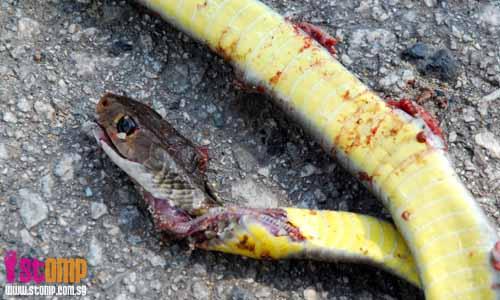
A bus ran over this snake as it was crossing the road, just as STOMPer Isaac was preparing to take a photo of it.
Here's what the STOMPer wrote in an email today (July 2):
"This morning as I was driving towards the end of Punggol Road, I saw a snake gliding its way across the road.
"As I was on a photography trip to Punggol this morning, I decided to pull to the side the road and capture the snake's path across the road.
"Before I could capture the first shot, an SBS bus number 82 came along and ran over the snake.
"I thought 'Oh no, this snake's life has been cruelly cut short through no fault of its own other than trying to navigate across a man-made object'.
"Bus 82 made a u-turn at the end of the road just slightly ahead and narrowly missed the snake on its return path. All the while, the bus driver was oblivious of the drama that had just unfolded as the creature he had crushed was too small to be seen.
"The snake's life and world was probably akin to that of the Lilliputians where the rest of the world are full of creatures of gigantic proportions that would be a constant threat.
"What could I have done in the case of this accident? Probably nothing, as the snake was badly crushed and probably had not survived as the photographs show.
"In any case, there is probably no hospital that would accept an injured wild animal that could be dangerous and poisonous as well."
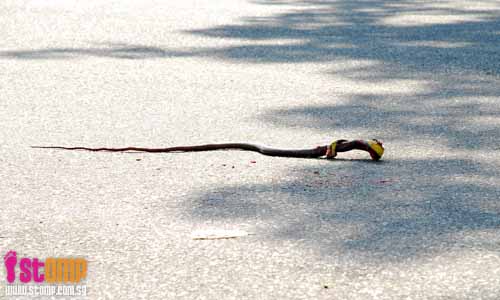
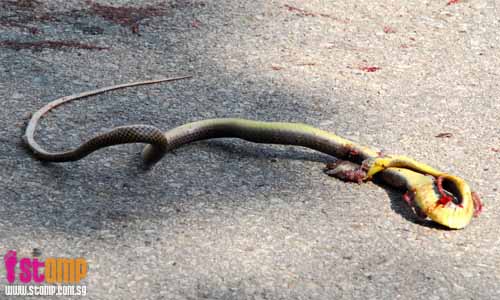
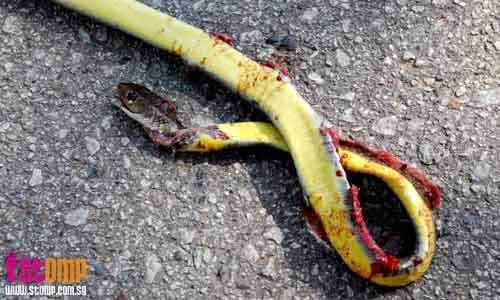
Related posts: Monitor lizard gets run over by vehicle in Pasir Ris (27th May 2009)
No jaywalking. Monkeys more law-abiding than humans (1st April 2009)
Chee Kong tells me that it looks like an Indo-Chinese rat snake (Ptyas korros), and I agree that it's the most likely identification.
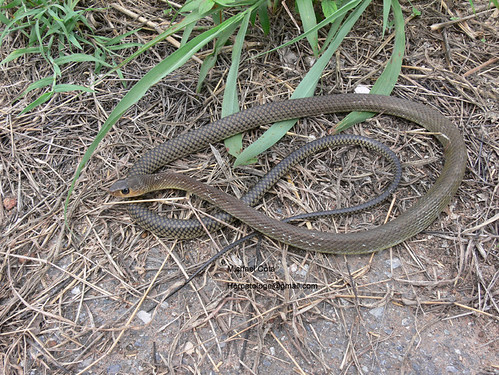
Indo-Chinese rat snake, Thailand;
(Photo by Herpetologe)
This is a species found throughout much of Asia, from eastern India and southern China to Indonesia. Here in Singapore, it's considered to be widespread but uncommon. It can grow quite large, up to 2.6 metres in length.
Largely terrestrial and diurnal, Indo-chinese rat snakes feed on rodents, frogs, lizards, birds and other smaller creatures. They're largely harmless, although there are some accounts which state that these snakes can get very aggressive when cornered, and have strong jaws that can cause nasty wounds when they bite.
Although once considered non-venomous, recent research reveals that rat snakes do in fact possess venom glands, just that the effects of the venom aren't noticeable in humans.
When threatened, rat snakes will rear up a little, puff up their throats and hiss loudly, in an attempt to appear more intimidating to a potential predator. This behaviour is seen in many species of snakes, and is taken to an extreme in the cobras.

Oriental rat snake (Ptyas mucosus) with throat inflated, India;
(Photo by Vivek vaidyanathan (sagivivek))
You can see an example of a rat snake (most probably an Oriental rat snake) attempting to defend itself from a king cobra (Ophiophagus hannah) by adopting a threat posture. Ignore the cringeworthy narration; when I watched this scene several years back, the original narration wasn't so puerile.
There are 8 species in the genus Ptyas, and besides the Indo-chinese rat snake, 3 other species have been recorded in Singapore.
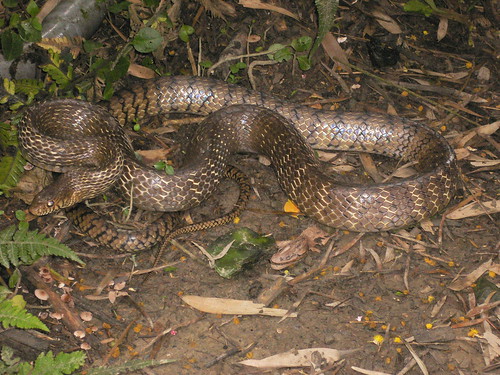
Oriental rat snake, Taiwan;
(Photo by Yugan Dali)
The status of the Oriental rat snake is Indeterminate, although given its supposed wide distribution across much of Asia, it is likely that it does occur here. This snake is supposedly capable of reaching 3.5 metres in length.
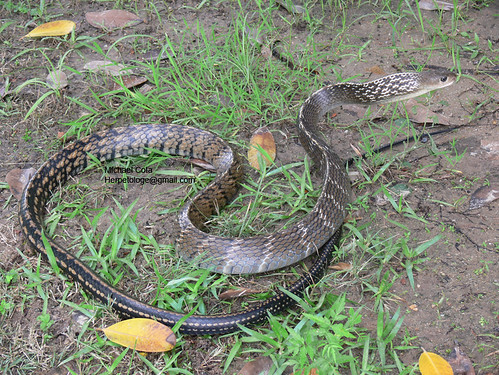
Keeled rat snake (Ptyas carinatus), Thailand;
(Photo by Herpetologe)
The keeled rat snake is a species that is said to grow to very large sizes, possibly reaching up to 4 metres. There is a particularly large preserved specimen in the public gallery of the Raffles Museum of Biodiversity Research (RMBR). Uncommon and recorded from the Central Nature Reserves, this snake can be easily confused with the king cobra.
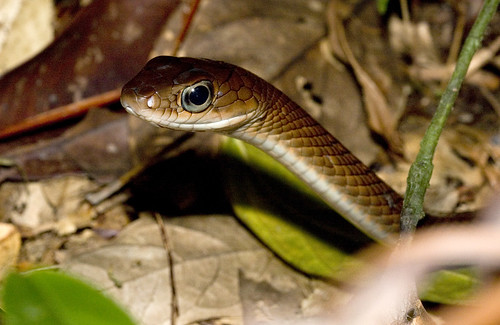
White-bellied rat snake (Ptyas fuscus), Lower Peirce;
(Photo by Marcus)
The white-bellied rat snake is known only from the Central Nature Reserves, and is rarely encountered. This is another large snake, reaching close to 3 metres in length.
These snakes belong to the family Colubridae, which has shrunk lately due to research which clarified the relationships among the caenophidian or advanced snakes. It turned out that several groups traditionally thought to be colubrids are actually more closely related to vipers or cobras, and hence "Colubridae" as we knew it then was a polyphyletic wastebasket group containing every advanced snake that wasn't a viperid or elapid.
The family traditionally known as the Colubridae has now been split up into 8 different families, as shown here:

The Colubridae still exists, but is a much smaller group now. In Singapore, the classification status of most of our 'colubrid' snakes remains unchanged.




Upper left: Oriental whip snake (Ahaetulla prasina);
(Photo by Ria)
Upper right: Paradise tree snake (Chrysopelea paradisi);
(Photo by hiker1974)
Lower left: Painted bronzeback (Dendrelaphis pictus);
(Photo by *Damselfly*)
Lower right: House wolf snake (Lycodon capucinus);
(Photo by *Damselfly*)
Here's a selection of colubrids commonly encountered in Singapore.


Left: Triangle keelback (Xenochrophis trianguligerus), Peninsular Malaysia;
(Photo by Steven Wong (ATKR))
Right: Painted mock viper (Psammodynastes pictus), Borneo;
(Photo by dennisikon)
However, the keelbacks and mock vipers now form their own separate family, the Natricidae.


Left: Puff-faced water snake (Homalopsis buccata), Nee Soon;
(Photo by Siyang)
Right: Dog-faced water snake (Cerberus rynchops), Sungei Buloh;
(Photo by Ria)
As do the water snakes, which now belong to the Homalopsidae.

White-spotted slug snake (Pareas margaritophorus), Kuantan;
(Photo by 2121studio)
The slug snakes have been split off to form the Pareatidae. The white-spotted slug snake is the only representative of this family known to occur in Singapore, and it is most likely an introduced species.
It was once thought that the majority of 'colubrid' species were non-venomous, and that the rest possessed venom that was not lethal to humans, with the exception of several African species. However, as mentioned earlier on, research has shown that even those species commonly thought to be non-venomous do in fact possess venom. Subaraj has a very interesting account of being envenomated by a blue-necked keelback (Macropisthodon rhodomelas), a natricid snake commonly regarded as non-venomous and harmless.
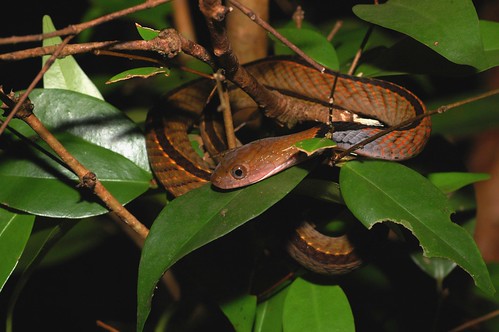
Blue-necked keelback, Singapore;
(Photo by Tiomanese)
In a previous post, I had briefly mentioned that snakes are vulnerable to traffic. Drawn to the road as a place to bask, as the tarmac absorbs heat more quickly than the surroundings, many snakes do not move out of the way of oncoming traffic until it is too late. Then there are people who will deliberately swerve to run over a snake that happens to be crossing the road. In this particular incident, no one is really to blame; I'm sure the bus driver had no idea that he had run over a snake, and I don't think there was anything that the person who posted this on STOMP could have done. Like so many other snakes that have been spotted as roadkill, this Indo-Chinese rat snake just happened to be in the wrong place at the wrong time.
Perhaps it might be feasible to look into the viability of creating wildlife crossings in certain areas, so as to reduce the number of casualties that come about when animals try to cross to road.